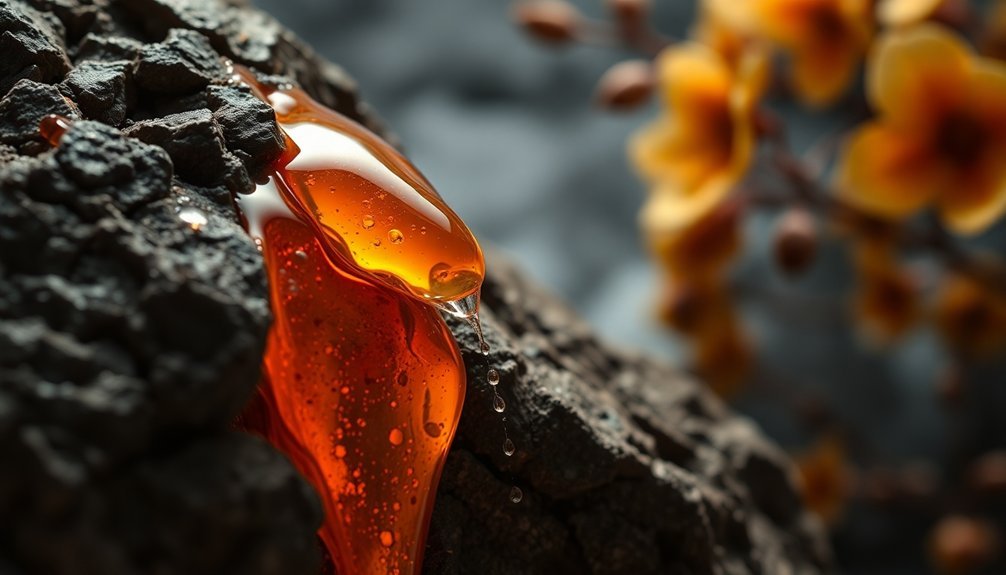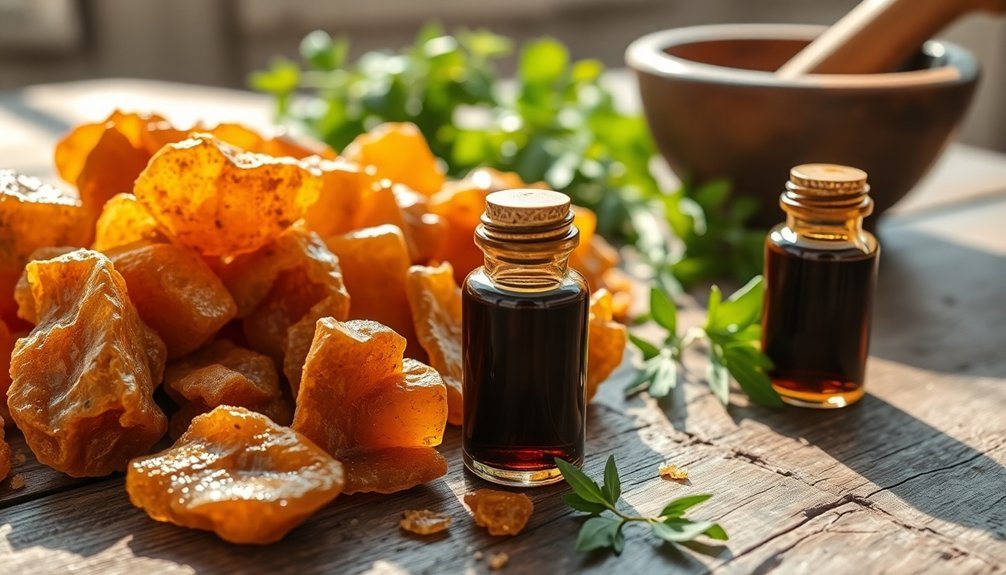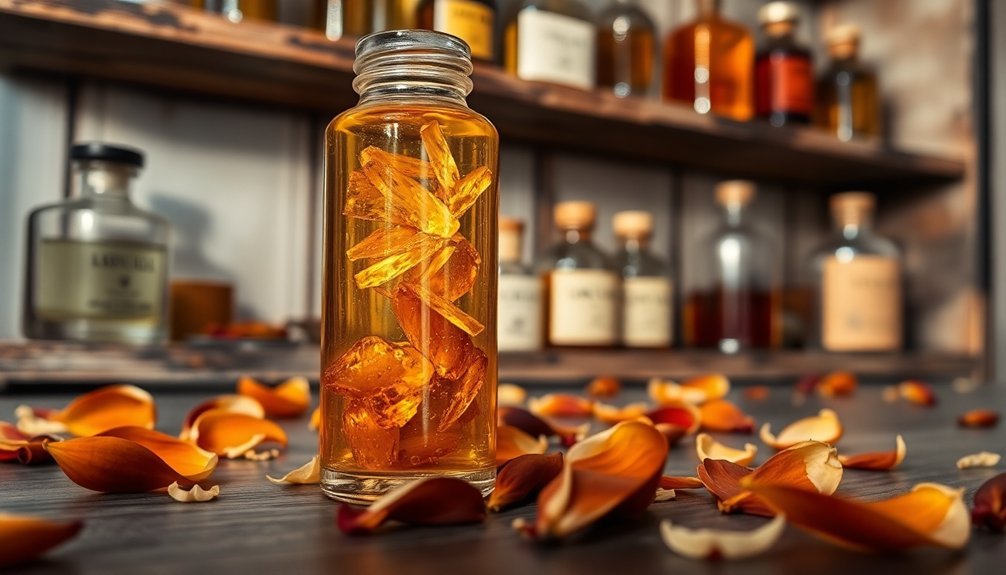Labdanum serves as a powerful natural fixative in perfumery due to its complex molecular structure containing cinnamic acid, terpenes, and aromatic compounds. You'll find it helps stabilize volatile fragrance notes while adding a sweet, resinous depth to compositions. When properly diluted and blended, it extends the longevity of your perfume by trapping scent molecules and maintaining their integrity. Understanding its proper preparation and storage can reveal labdanum's full fixative potential in your formulations.
Understanding the Science Behind Labdanum's Fixative Properties

While many perfume ingredients offer pleasant aromas, labdanum stands out for its complex molecular structure that makes it an exceptional fixative.
You'll find a rich symphony of compounds within labdanum, including cinnamic acid, various terpenes, and aromatic molecules that work together to anchor other scents.
When you're creating a perfume, labdanum's diverse chemical composition helps stabilize volatile fragrance notes.
Its monoterpenes, diterpenes, and sesquiterpenes form a molecular framework that traps and holds other scent molecules, preventing them from evaporating too quickly.
The presence of vanillin and coumarin adds another dimension to its fixative properties, as these compounds not only contribute sweetness but also help blend and harmonize different fragrance elements.
This molecular complexity is what makes labdanum such a valuable base note in perfumery, and its resinous, balsamic qualities provide depth that has enchanted perfumers for generations.
Essential Tools and Materials for Working With Labdanum
Success in working with labdanum requires a specific set of tools and materials tailored to your extraction method and intended use.
You'll need appropriate extraction equipment, whether it's solvent extraction glassware or steam distillation apparatus. Traditional harvesters also employ a rake-like ladanisterion tool for collecting the raw resin directly from rockrose plants. Don't forget essential safety gear like protective gloves and goggles when handling this sticky resin.
For storage, you'll want high-quality glass containers with tight seals to preserve labdanum's aromatic properties. Keep these in a cool, dark place to prevent degradation.
When you're ready to blend, you'll need complementary materials like myrrh, frankincense, floral essences, and carrier oils.
The precise tools you choose will depend on whether you're working with the raw resin, absolute, or essential oil form of labdanum, but proper storage containers and safety equipment are non-negotiable basics.
Step-by-Step Guide to Preparing Labdanum Tincture

Creating a high-quality labdanum tincture involves four main stages: collection, dilution, maceration, and application. You'll need to follow these critical steps carefully to guarantee peak results.
1. Start by collecting a small amount of labdanum absolute using a spatula or toothpick, placing it in a sterile amber bottle.
If it's too viscous, warm it gently in water for 10-15 minutes.
2. Dilute the absolute in high-proof alcohol or perfumer's base using a 1:3 ratio.
The dark brown liquid will blend seamlessly with the solvent for optimal results.
Warm the solvent slightly in a bain-marie to ease the mixing process.
3. Allow the mixture to macerate, stirring occasionally with a spatula.
Filter if needed for clarity.
4. Use the finished tincture with a pipette or dropper in your perfume formulations, combining it with other aromatics to create complex fragrances with depth and staying power.
Blending Ratios and Proportions for Optimal Fixation
To achieve ideal fixation with labdanum in perfumery, you'll need to master precise blending ratios that balance its potent properties with other fragrance components.
For a 20% oil concentration perfume, start by using 10ml of labdanum fixative per 30ml of fragrance oil. You'll need to adjust these proportions if you're working with different oil concentrations.
When blending, use perfume strips to test the strength of your combinations.
Consider labdanum's warm, resinous character and how it interacts with other notes. Remember to factor in evaporation rates and longevity as you blend.
You'll want to balance your fixative with propylene glycol, distilled water, and perfume-grade alcohol to create a stable composition.
Let your senses guide you through the process while maintaining proper ratios for ideal results.
Natural Alternatives and Complementary Fixatives

While labdanum serves as a powerful fixative, perfumers have multiple natural and synthetic alternatives at their disposal.
You'll find benzoin and myrrh providing similar resinous qualities, while tonka absolute and sandalwood offer complementary fixing properties that enhance a fragrance's longevity.
For ideal results, you can combine natural and synthetic fixatives to create well-rounded perfumes:
- Blend benzoin with Galaxolide for a balanced sweet and musky foundation
- Layer patchouli with Iso E Super to achieve depth and woodiness
- Combine orrisroot with Ambroxan for a powdery, amber-like stability
- Mix Tolu balsam with synthetic musks to create oriental depth
When working with these alternatives, remember that maceration is key to ensuring all components blend harmoniously and achieve maximum fixing potential.
Common Mistakes to Avoid When Using Labdanum
You'll need to carefully control labdanum's concentration in your perfume blends, as using too much can overpower other notes while using too little won't achieve the desired fixative effect.
When selecting a solvent, you must avoid oils like jojoba and instead opt for alcohol-based solutions that guarantee proper integration of the labdanum into your blend.
Your choice of solvent directly impacts how well the labdanum performs as a fixative, with alcohol-based dilutions typically yielding superior results in maintaining the overall fragrance composition.
Proper Concentration Matters Most
Since labdanum's potency can make or break a perfume blend, maintaining proper concentration levels isn't just a suggestion – it's vital.
You'll need to be especially mindful of proper dilution rates to achieve the perfect balance in your fragrance composition.
- Start with a 50% dilution of labdanum absolute in alcohol before adding it to your perfume blend.
- Keep the overall concentration between 3-5% in your base notes to avoid overwhelming other fragrance elements.
- Warm the labdanum carefully to achieve proper consistency, but allow it to cool before final bottling.
- Filter out any particulates using cheesecloth or paper towels to guarantee a smooth, professional result.
Remember that you can't rush the process – proper maturation after adding labdanum is vital for achieving that perfectly balanced, long-lasting fragrance.
Solvent Selection Affects Performance
Selecting the right solvent can make or break your labdanum-based fragrance project. When working with labdanum, you'll want to avoid common pitfalls that can compromise your blend's quality.
Don't skip warming the resin before use, as cold labdanum is nearly impossible to work with effectively.
You'll find that alcohol is your best friend when diluting labdanum – aim for a 50% solution using Everclear or similar high-proof spirits.
Don't make the mistake of using carrier oils like jojoba, which will cause unsightly separation and floating black particles.
Always weigh your ingredients precisely on a scale to guarantee consistent results.
Remember to mix your labdanum and solvent in a clean container, and give your blend time to mature.
Rushing this process can lead to unstable, unbalanced fragrances.
Storage and Shelf Life of Labdanum-Based Fixatives

To maximize the longevity of labdanum-based fixatives, proper storage conditions are essential.
You'll need to store your fixatives in a cool, dark environment between 60-70°F (15-21°C) to maintain their effectiveness. Keep your labdanum preparations in tightly sealed, dark glass containers to protect them from light degradation and prevent volatile compounds from evaporating.
- Place bottles upright in a drawer or closet away from heat sources and direct sunlight
- Use the original packaging or dark-tinted containers for ideal light protection
- Confirm caps are tightly sealed after each use to prevent oxidation
- Track your fixatives' aging process in a perfume journal, noting any changes in scent or performance
With proper storage, your labdanum-based fixatives can maintain their potency for 3-5 years, enhancing their value in your perfume formulations.
Testing and Evaluating Fixative Performance
Measuring the effectiveness of labdanum fixatives requires systematic testing procedures that combine both analytical and sensory evaluation methods.
You'll find that perfume experts use evaporation tests on blotters, applying 1 mg of fragrance with and without labdanum fixative. They track the results through GLC and UV analysis at specific intervals to quantify the fixative's impact.
For a real-world assessment, you can rely on panel testing where trained evaluators assess the fragrance on subjects' forearms using calibrated pipettes.
They'll score the intensity and character over several hours to determine labdanum's effectiveness. To validate these findings, you'll need comparative studies that measure labdanum against control compositions without fixatives, creating graphs that demonstrate improved fragrance longevity and stability over time.
Frequently Asked Questions
Can Labdanum Cause Allergic Reactions When Used in Perfumes?
Yes, you can experience allergic reactions to labdanum in perfumes. It contains compounds that might trigger skin irritation, rashes, or respiratory issues, especially if you're sensitive to terpenes or resin acids.
How Does Labdanum Compare to Synthetic Fixatives in Terms of Cost?
You'll find labdanum is more expensive than synthetic fixatives since it's naturally sourced from Mediterranean plants. While synthetics can be mass-produced cheaply, labdanum's extraction process and limited availability drive up costs.
Does Labdanum's Fixative Power Vary Between Different Fragrance Families?
You'll find that labdanum's fixative power remains consistent across fragrance families due to its complex chemical structure. However, it's particularly effective in oriental and chypre scents where its natural properties shine through.
Can Labdanum Alter the Original Scent Profile of Other Perfume Ingredients?
Yes, labdanum can modify your fragrance's original profile by adding earthy, sweet, woody, and leathery notes. You'll notice it introduces warm, balsamic undertones while harmoniously blending with and enhancing other scent ingredients.
Is Sustainably Sourced Labdanum Readily Available in the Perfume Industry?
Yes, you'll find sustainably sourced labdanum through specialized suppliers, mainly from the Spanish Mediterranean coast. It's becoming more available as companies implement eco-friendly practices and meet growing demand for sustainable ingredients.
In Summary
You'll find labdanum's role as a perfume fixative is truly indispensable for creating long-lasting fragrances. By understanding its resinous properties, proper preparation methods, and ideal blending ratios, you're equipped to harness its full potential. Remember to store your labdanum-based fixatives properly and test their effectiveness regularly. Whether you're a novice or experienced perfumer, this natural fixative will enhance your fragrance creations considerably.





Leave a Reply